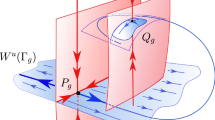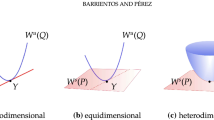Abstract
We construct open sets of degenerate unfoldings of heterodimensional cycles of any co-index \(c>0\) and homoclinic tangencies of arbitrary codimension \(c>0\). These type of sets are known to be the support of unexpected phenomena in families of diffeomorphisms, such as the Kolmogorov typical co-existence of infinitely many attractors. As a prerequisite, we also construct robust homoclinic tangencies of large codimension which cannot be inside a strong partially hyperbolic set.


Similar content being viewed by others
References
Avila, A., Crovisier, S., Wilkinson, A.: \({C}^1\) density of stable ergodicity. arXiv preprint arXiv:1709.04983 (2017)
Asaoka, M.: Hyperbolic sets exhibiting \(C^1\)-persistent homoclinic tangency for higher dimensions. Proc. Am. Math. Soc. 136(2), 677–686 (2008)
Bochi, J., Bonatti, C., Díaz, L.J.: Robust criterion for the existence of nonhyperbolic ergodic measures. Commun. Math. Phys. 344(3), 751–795 (2016)
Berger, P., Crovisier, S., Pujals, E.: Iterated functions systems, blenders and parablenders. In: Fractals and Related Fields III: Proceedings of the Conference, Ile de Porquerolles (France), 2015 (in press) (2016)
Bonatti, C., Díaz, L.J.: Persistent nonhyperbolic transitive diffeomorphisms. Ann. Math. (2) 43(2), 357–396 (1996)
Bonatti, C., Díaz, L.J.: Robust heterodimensional cycles and \(C^1\)-generic dynamics. J. Inst. Math. Jussieu 7(3), 469–525 (2008)
Bonatti, C., Díaz, L.J.: Abundance of \(C^1\)-homoclinic tangencies. Trans. Am. Math. Soc. 264, 5111–5148 (2012)
Bonatti, C., Díaz, L.J., Viana, M.: Dynamics Beyond Uniform Hyperbolicity, volume 102 of Encyclopaedia of Mathematical Sciences. Springer, Berlin; A Global Geometric and Probabilistic Perspective. Mathematical Physics, III (2005)
Berger, P.: Generic family with robustly infinitely many sinks. Inventiones Mathematicae 205(1), 121–172 (2016)
Berger, P.: Emergence and non-typicality of the finiteness of the attractors in many topologies. Proc. Steklov Inst. Math. 297(1), 1–27 (2017)
Berger, P.: Generic family displaying robustly a fast growth of the number of periodic points. ArXiv e-prints (2017)
Biebler, S.: Persistent Homoclinic Tangencies and Infinitely Many Sinks for Residual Sets of Automorphisms of Low Degree in \({C}^{3}\) (2016)
Barrientos, P.G., Ki, Y., Raibekas, A.: Symbolic blender-horseshoes and applications. Nonlinearity 27(12), 2805 (2014)
Barrientos, P.G., Raibekas, A.: Robust cycles and tangencies of large codimension. Nonlinearity 30, 4369–4409 (2017)
Barrientos, P.G., Raibekas, A.: Robustly non-hyperbolic transitive symplectic dynamics. Discrete Contin. Dyn. Syst. A 38(12), 5993 (2018)
Dujardin, R.: Non-density of stability for holomorphic mappings on \({\mathbb{P}} ^k\). Journal de l’École polytechnique-Mathématiques 4, 813–843 (2017)
Gavrilov, N.K., Šil’nikov, L.P.: On three-dimensional dynamical systems close to systems with a structurally unstable homoclinic curve. I. Sb. Math. 17(4), 467–485 (1972)
Gonchenko, S.V., Shilnikov, L.P., Turaev, D.V.: On dynamical properties of multidimensional diffeomorphisms from newhouse regions: I. Nonlinearity 21(5), 923 (2008)
Gonchenko, S.V., Turaev, D.V., Shil’nikov, L.P.: On the existence of Newhouse regions in a neighborhood of systems with a structurally unstable homoclinic Poincaré curve (the multidimensional case). Dokl. Akad. Nauk 329(4), 404–407 (1993)
Krupka, M., Krupka, D.: Jets and contact elements. In: Proceedings of the Seminar on Differential Geometry, Vol. 2, pp. 39–85. Mathematical Publications (2000)
Michor, P.W.: Manifolds of Differentiable Mappings. Shiva Mathematics Series. Shiva Pub, Jawali (1980)
Newhouse, S.E.: Nondensity of axiom A(a) on S2. In: Global Analysis (Proceedings of the Symposium Pure Mathematics, Vol. XIV, Berkeley, CA 1968), pp. 191–202. American Mathematical Society, Providence (1970)
Newhouse, S.E.: Diffeomorphisms with infinitely many sinks. Topology 13, 9–18 (1974)
Newhouse, S.E.: The abundance of wild hyperbolic sets and nonsmooth stable sets for diffeomorphisms. Inst. Hautes Études Sci. Publ. Math. 50, 101–151 (1979)
Nassiri, M., Pujals, E.R.: Robust transitivity in Hamiltonian dynamics. Ann. Sci. Éc. Norm. Supér. 45(2), 191–239 (2012)
Pugh, C., Shub, M.: Stably ergodic dynamical systems and partial hyperbolicity. In: International Conference on Dynamical Systems (Montevideo, 1995), pp. 182–187, Longman, Harlow (1996). Pitman Research Notes Mathematics Series
Palis, J., Viana, M.: High dimension diffeomorphisms displaying infinitely many periodic attractors. Ann. Math. (2) 140(1), 207–250 (1994)
Rojas, J.D.: Generic Amilies Exhibiting Infinitely Many Non-uniform Hyperbolic Attractors for a Set of Total Measure of Parameters. PhD thesis, Instituto de Matemática Pura e Aplicada (IMPA) (2017)
Romero, N.: Persistence of homoclinic tangencies in higher dimensions. Ergod. Theory Dyn. Syst. 15(4), 735–757 (1995)
Taflin, J.: Blenders Near Polynomial Product Maps of \({\mathbb{C}}^2\) (2017)
Acknowledgements
We thank P. Berger who told us the ideais behind his proof in [10]. We are grateful to J. Rojas for helping us to understand P. Berger’s articles and for the initial discussions on this project. We also thank the anonymous referee for his comments and pointing out some problems. Funding was provided by Ministerio de Educación, Cultura y Deporte (Grant No. MTM2017-87697-P) and Conselho Nacional de Desenvolvimento Científico e Tecnológico.
Author information
Authors and Affiliations
Corresponding author
Additional information
Publisher's Note
Springer Nature remains neutral with regard to jurisdictional claims in published maps and institutional affiliations.
Appendix A: Estimates for the Folding Manifold of Example 3.2
Appendix A: Estimates for the Folding Manifold of Example 3.2
We consider the \((ss+c)\)-dimensional \(C^\infty \)-manifold of Example 3.2 given by
where \(t=(t_1,\dots ,t_u,\dots ,t_c) \in [-\epsilon ,\epsilon ]^c\) and \(h(t)=(h_1(t),\dots ,h_c(t))\) with
Let \(t=t(E)\) be the \(C^{r-1}\)-function on \(\mathcal {C}^{{G}}\) computes in Example 3.2. We have that:
Proposition A.1
For every \(\varepsilon >0\) suffices small there is a neighborhood \(\mathcal {C}^{{G}}\) of \(E^u\) such that
Thus, \(\mathcal {S}\) is a \(({\alpha ,}\nu ,\delta )\)-folding manifold for any \(\nu >0\) such that \((1+\varepsilon )\nu <\delta \).
Proof
First of all, notice that for all \(t\in [-\epsilon ,\epsilon ]^c\), it holds that
Hence, taking \(\epsilon >0\) small enough we have that \(\Vert Dh\Vert _\infty =1\). On the other hand, by Cramer’s rule we get that the solution of the linear system \(At= \mathbf {c}\) is given by
where \(A^*_{i}\) is the matrix formed by replacing the ith column of A by the column vector \(\mathbf {c}\). In order to compute Dt we write the variable of t by \(E=\langle v_{1},\dots ,v_u\rangle \) with \(v_k=(a_k,b_k,c_k)\in \mathbb {R}^{ss}\times \mathbb {R}^{u}\times \mathbb {R}^c\) and then
Moreover, since the matrix A does not depend on the variables \(a_k\) we get that \(\partial _{a_k}t=0\). In the sequel we will use the symbol \(D_{k}\) to denote any partial derivative of the form \(\partial _{b_{k\iota }}\) or \(\partial _{c_{k\iota }}\). For each \(i=1,\dots ,c\), using Jacobi’s formula it follows that
In particular, since \(\mathbf {c}(E^u)=0\) then \(\det A^*_i(E^u)=0\), and \(\det A(E^u)=2\), we obtain that
where \(\mathrm {Adj}(A^*_i)\) is the adjugate matrix of \(A^*_i\). Notice that
where \(\sigma _i=2\) if \(i\not =1\) and \(\sigma _i=1\) otherwise (\(i=1\)). From this follows that
If \(D_k\) is either, \(\partial _{b_{k\iota }}\) for \(\iota =1,\dots ,u\) or \(\partial _{c_{k\iota }}\) for \(\iota =u+1,\dots ,c\) then \(D_k\mathbf {c}=0\) and thus \(D_kt_i(E^u)=0\). Otherwise,
Therefore
Since Dt varies continuously with respect to E we have that \(\Vert Dt(E)\Vert _\infty \) is close to \(\Vert Dt(E^u)\Vert _\infty \) for any E close enough to \(E^u\). Thus, shrinking \(\mathcal {C}^{{G}}\) if necessary, this implies that \(\Vert Dt\Vert _\infty \le 1+\varepsilon \) over \( \mathcal {C}^{{G}}_\alpha \). Hence, \(C=\Vert Dh\Vert _\infty \cdot \max \{1,\Vert Dt\Vert _\infty \} \le 1+\varepsilon \) for a fixed but arbitrarily small \(\varepsilon >0\).
This \(({\alpha ,}\nu ,\delta )\)-folding \(C^r\)-manifold \(\mathcal {S}\) induces a \(C^{r-1}\)-disc
Set \(h^{{G}}=\mathscr {P}\circ \mathcal {H}^{{G}}\). Here \(\mathscr {P}\) denotes the standard projection onto \(\mathbb {R}^c\). We consider
with
where \(\overline{B}_\rho (0)\) denotes a closed ball of radius \(\rho >0\) at 0 velocity of the jets over \(\mathbb {R}^{ss}\times G(u,m)\).
Proposition A.2
For every \(\varepsilon >0\) suffices small there are \(\rho >0\) and a neighborhood \(\mathcal {C}^{{G}}\) of \(E^u\) so that
Thus, \(\widehat{\mathcal {H}}^{{G}}\) is a \(({\alpha ,}\nu ,\delta )\)-horizontal disc for any \(\nu >0\) such that \((1+\varepsilon )\nu <\delta \).
Proof
Observe that \(h^{{G}}(E)=h(t(E))\). In this way,
for \(E=(E_a)_a \in C^d(\mathbb {I}^k,G(u,m))\) with \(E_0\in \mathcal {C}^{{G}}_\alpha \). Denoting \(t_a=t(E_a)\) for all \(a\in \mathbb {I}^k\), we can rewrite (A.1) as
with \(t_0\) small enough in norm. Therefore,
where \(\widehat{t}(J(E))=J(t\circ E)\). We want to compute \(\Vert D\widehat{h}^{{G}}(J(E^u))\Vert _{\infty }\) where \(E^u=(E^u_a)_a\) with \(E^u_a=E^u_0=\{0^{ss}\}\times \mathbb {R}^u\times \{0^c\}\) for all \(a\in \mathbb {I}^k\). Hence \(J(E^u)=(E^u_0,0)\). By a straightforward calculation using Faà di Bruno’s formula, we have
By means of a similar computation we can show that
where \(t^{u}=(t^{u}_a)_a\) with \(t^{u}_a=t(E^u_a)=t(E^u_0)=0\) for all \(a\in \mathbb {I}^k\) and hence \(J(t^{u})=0\). Finally putting together (A.2)–(A.4) we get that
By continuity with respect to J(E), shrinking \(\mathcal {C}^{{G}}\) if necessary and taking \(\rho >0\) small enough, we have \(\Vert D\widehat{h}^{{G}}\Vert _{\infty } \le 1+\varepsilon \) over \(\big ([-2,2]^{ss}\times \mathcal {C}^{{G}}_\alpha \big ) \times \overline{B}_\rho (0)\) for a fixed but arbitrarily small \(\varepsilon >0\). This completes the proof.
Rights and permissions
About this article
Cite this article
Barrientos, P.G., Raibekas, A. Robust Degenerate Unfoldings of Cycles and Tangencies. J Dyn Diff Equat 33, 177–209 (2021). https://doi.org/10.1007/s10884-020-09857-0
Received:
Revised:
Published:
Issue Date:
DOI: https://doi.org/10.1007/s10884-020-09857-0




